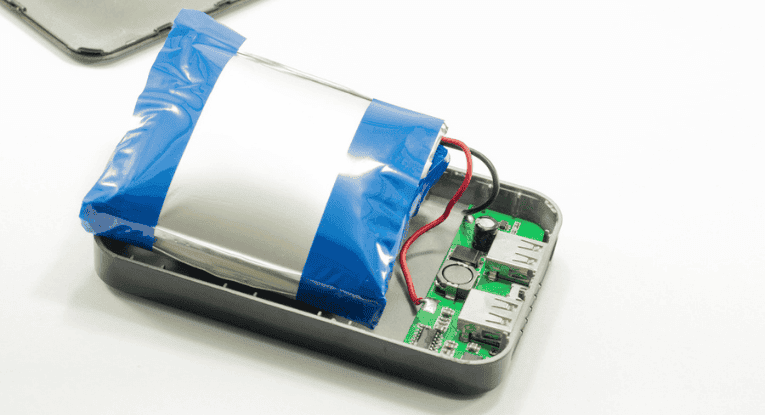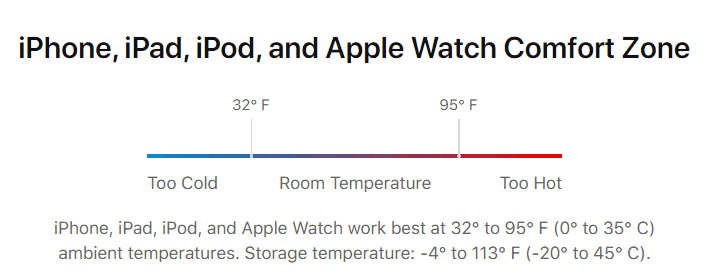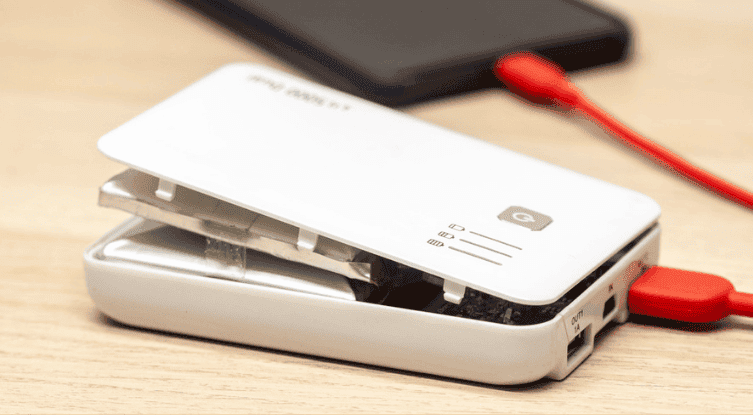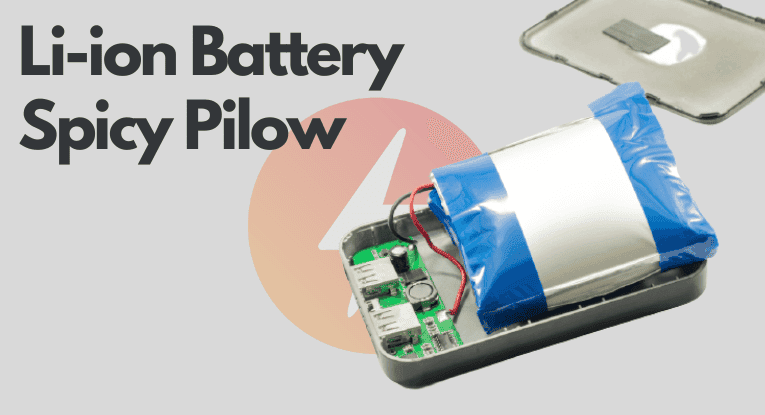Swelling is one of the most common issues with lithium-ion batteries. They resemble a pillow as they expand, which is why they’ve earned the nickname spicy pillow or forbidden pillow. If you’ve ever had a spicy pillow, you already know how cute they look and how tempting they are to touch, but you need to be cautious and avoid puncturing them as they are extremely dangerous.

Key Points
Here are the main points that I address in the article. For more details on each of them, please have a look at the dedicated section.
- Swelling in Lithium-Ion Batteries: Commonly known as the “spicy pillow” effect, swelling in lithium-ion batteries is a significant safety concern. We’ll look at how and why this happens.
- Causes of Swelling: Overcharging, physical damage, extreme temperatures, and deep discharging are primary causes.
- Dangers: Swollen batteries can be hazardous, posing risks of fire and explosion, especially if punctured.
- Prevention: Avoid overcharging and deep discharging, minimize physical impacts, and keep batteries away from extreme temperatures.
Understanding the Internal Chemistry Behind the “Spicy Pillow” Effect
The “spicy pillow” effect in lithium-ion batteries is primarily a result of internal gas buildup. Here’s a breakdown of the internal chemistry:
- Electrochemical Reactions: Lithium-ion batteries function through electrochemical reactions between the anode (negative electrode) and cathode (positive electrode). These reactions enable the flow of lithium ions and electrons, creating electrical energy.
- Gas Formation: When a battery is overcharged or exposed to other stress factors like physical damage or extreme temperatures, these electrochemical reactions can become unbalanced. This imbalance can lead to the production of gases such as carbon dioxide, oxygen, and others.
- Swelling: The gases produced accumulate within the battery’s casing. Since lithium-ion batteries are typically enclosed in a rigid but flexible casing, this gas buildup leads to visible swelling, creating the “spicy pillow” effect.
- Electrolyte Breakdown: Overcharging can also cause the breakdown of electrolytes, further contributing to gas formation. High temperatures exacerbate this breakdown, accelerating the swelling process.
Main Factors That Cause The Notorious Pillow Shape in Batteries
There are several reasons that lead to expanded Li-ion batteries. Let’s explore them one by one.
1. Overcharging
One of the most common ones is overcharging. In this scenario, overcharge increases parasitic processes between the electrodes and electrolytes, resulting in the release of heat and gases. In addition, if the manufacturer utilizes substandard cells and designs them with low anode-to-cathode stoichiometric ratios or with particle contamination, you may soon notice battery problems. As a consequence, a battery pillow might form.
2. Deep Discharging
A deep discharge is another common cause of battery bloating. This issue is particularly prevalent with gadgets that consumers use only a few times over an extended period of time, such as drones, and then leave discharged in their boxes. Remember, any factor that raises a battery’s self-discharge rate is detrimental and causes your battery to degrade more quickly.
Most notably, Canadian Light Source (CLS) synchrotron scientists published their findings in the Journal of the Electrochemical Society after studying an overworked battery. They depleted a battery to a point where its voltage fell below a crucial level. The CLS team utilized computed tomography, an x-ray method, to observe what happens within the battery when it expands.
Toby Bond, a researcher at CLS, explained that lithium-ion batteries are typically wrapped in a spiraling “Swiss roll” or “jelly roll” design to fit as many energy-producing layers as feasible, this configuration might cause issues if gas develops inside.
3. Physical Incidents
Another factor that can a battery to expand is physical force, regardless of whether the cell was damaged during manufacture or during product usage. Thus actions like hitting, dropping, clamping, puncturing, or any other action that deforms the battery can be a leading cause for expansion.
4. Temperature
If a device’s battery is exposed to extremely high or extremely low temperatures, the battery’s capacity will degrade and finally bulge. This is why you should avoid leaving devices with Li-ion batteries (phones, laptops, power banks, tablets, etc) exposed to extreme heat, such as a car’s dashboard during a hot summer’s day.

Are Pillowed Batteries Dangerous?
Yes. The gas trapped inside the battery is extremely hazardous due to its toxicity and flammability. If you have a gadget with a bloated battery, avoid charging it since there is a strong possibility that the battery may catch fire or possibly explode.
Additionally, never leave the battery in the gadget since another member of your household may want to use it and cause an incident. Furthermore, keeping the battery inside the gadget might cause damage to the device itself.
If the battery is detachable, try to remove it; if not, take it to an electronic repair shop. If the battery is detachable but difficult to remove due to swelling, refrain from removing it to avoid an irreversible chemical reaction that will lead to fire and/or explosion. To prevent any mishaps when carrying the item to an electrical repair shop, place it in a non-flammable container.
Please replace any expanded battery even if it’s only slightly enlarged, especially if you are traveling by plane. Airlines have restrictive rules about battery-powered gadgets. They often inspect the devices before passenger onboarding to ensure they operate properly and show no signs of bulging. Even if your gadget does not switch on, they will prohibit you from onboarding because they believe it to be hazardous.
Since batteries have become a major safety concern, the Federal Aviation Administration (FAA) started recording battery-related incidents in 2006. According to the report, passenger planes had the most incidents: 187 (64%) out of 289. Check out the data in a visual format here.
On the other hand, cargo planes experienced just 77 battery-related incidents. Additionally, the report indicated that there were between one to eight incidents between 2006 and 2014. However, a significant spike began in 2011, which is expected given the growing usage of battery-powered devices in recent years.
Can a Bloated Battery Explode Even if Not Plugged In?
Yes, even while not in use, a swollen battery might explode or catch fire. While the probability of the battery exploding on its own is small, any pressure or temperature changes increase the likelihood of exploding or igniting. This is why you need to treat any device in such a condition extremely carefully. The best course of action would be to recycle the batter as soon as you notice the first signs of bulging.

What Happens if a Swollen Battery is Popped?
If the bloated battery is punctured, the gas within will rapidly release, possibly starting a fire or exploding. Apart from being toxic and hazardous, the pressure release, flame, and explosion can cause serious injury to any person nearby.
You should never attempt to puncture or press on a bloated battery, even out of curiosity, as this will result in an explosion. Apart from the safety risks, you will almost certainly lose the device if something happens.
How to Prevent Batteries to Become Swollen
1. Avoid Overcharging
As previously mentioned, the most common cause of swollen batteries is overcharging. As a result, you should avoid the habit of overnight charging. However, if your smartphone or other device has a smart charging feature that automatically stops the charging process before it reaches 100% and only resumes in the morning, then you can safely leave it charging overnight.
2. Avoid Deep Discharging
You should not leave your batteries depleted for an extended period of time. In this situation, the battery initially loses capacity and then begins to expand. To avoid battery swelling due to over-discharge, use the gadget at least once a week and charge it to about 85%.
3. Avoid Impacts
Dropping your device or any other physical damage to it may result in battery swelling. Therefore, check for damages such as shell cracks, whether it’s a cellphone, a power bank, or another item. Also, after a day or two, recheck the device to confirm it hasn’t swelled, as the battery may do so later.
4. Avoid High Temperatures
As previously mentioned, lithium batteries are temperature-sensitive. Hence, to avoid decreasing the battery’s life and causing it to swell, you should never use or put it in a hot environment. For example, avoid using a power bank in direct sunlight on a beach during the summer.
While a bulging battery may suggest poor charging and incorrect use, it may also indicate that the battery is reaching the end of its life. Lithium-ion batteries have a life expectancy of around 500 charges and discharges; after this point, the batteries begin to swell.
Conclusion
The phenomenon of lithium-ion batteries swelling is a critical safety issue that demands attention. The swelling is caused by internal gas buildup due to various factors. These swollen batteries pose significant risks, including the potential for fire and explosion, especially if punctured.
Understanding the causes and taking preventive measures are essential for safe battery usage. Especially considering the increasing prevalence of lithium-ion batteries in everyday devices. Consumers need to be aware of these risks and how to mitigate them.
